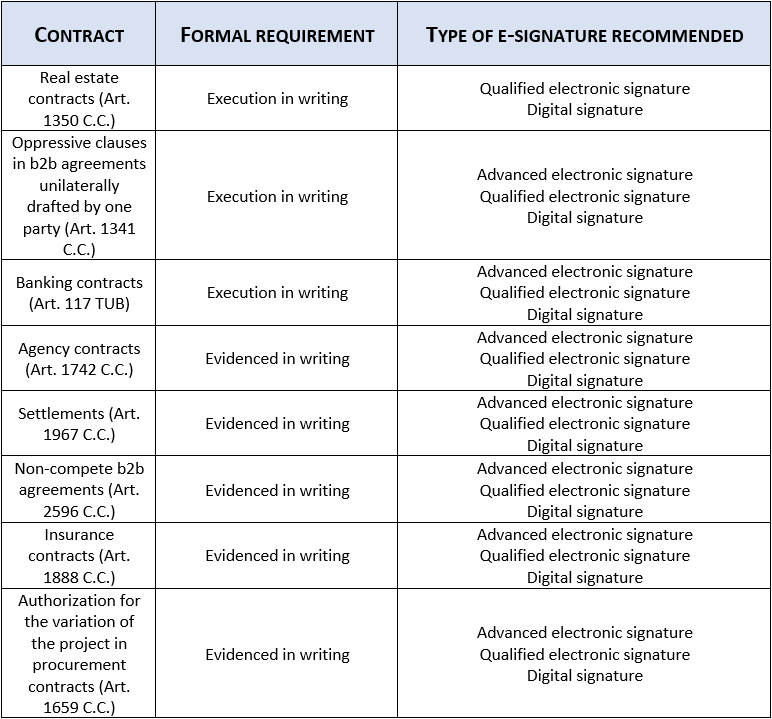Italy has been placed under quarantine and companies had to adapt quickly in order to manage their businesses remotely and, in many cases, postpone those activities that could not be carried out without meetings and execution of hard-copy documents. In this context, having a document management system based on digital processes can make a difference.
Italy was one of the first European countries to regulate the execution of electronic documents and the use of electronically created documents is widely encouraged by state legislation and regulation. As a result, it offers a number of options, such as one time passwords (OTPs), biometric signatures, qualified signatures, etc. In some instances, even a simple email may be enough.
Execution of contracts and, more broadly, execution of documents can definitely occur remotely without the need to meet in person. You can easily exchange signed documents by certified mail or use electronic signatures if you do not have a printer available to you. Of course, you may want to be sure that the option you choose has the same effects as a handwritten signature, and that should be carefully evaluated on a case-by-case basis on the basis of the characteristics of the electronic signature and the type of document to be signed. Indeed, although the sector has been harmonized at an EU level by the eIDAS Regulation (Regulation (EU) 910/2014), Italian law presents a few peculiar characteristics that both international and local players need to consider when they intend to execute documents remotely.
Although in principle parties may at their own discretion decide how to execute contracts and documents, Italian contract law provides that certain contracts shall be entered into in writing (e.g., real estate contracts) or by notarial deed (e.g., deeds of incorporation of capital companies). In such cases, lack of the prescribed form triggers the invalidity of such contracts (see, for instance, Article 1350 of the Italian Civil Code). Additionally, in some cases Italian contract law dictates that certain contracts may be enforced only if there is written evidence of parties’ consent (this is the case, for instance, for agency contracts—see Article 1742 of the Italian Civil Code).
There are several types of electronic signatures available, each of which ensures a different degree of security and reliability:
- what are known as “simple” electronic signatures, e., data in electronic form that is attached to or logically associated with other data in electronic form and is used by the signatory to sign—in principle these signatures present a lower degree of security than other types;
- advanced signatures, instead, ensure higher security standards, as they are (i) uniquely linked to the signatory, (ii) capable of identifying the signatory, (iii) created using data that the signatory can, with a high level of confidence, use under their sole control, and (iv) linked to the data signed therewith in such a way that any subsequent change in the data is detectable;
- qualified electronic signatures are advanced electronic signatures that present higher security standards, since they are created by a qualified electronic signature creation device (g., a token), which is based on a qualified certificate for electronic signatures;
- In Italy, we also have digital signatures, which were the first electronic signatures regulated by the law (long before the eIDAS Regulation): these are qualified electronic signatures based on a specific type of technology, e., a cryptographic double-key system. Generally, this is the type of electronic signature that is applied in Italy when a smartcard is used;
- Italian law also provides for an additional electronic signature process based on the Public System of Digital Identity (Sistema Pubblico di Identità Digitale—“SPID”). However, to date implementing regulations have not been issued (the guidelines are currently under public consultation).
As a consequence, the Italian Digital Administration Code (Legislative Decree of March 7, 2005, No. 82—“CAD”) provides that only documents signed used certain types of electronic signatures have the same effect as documents executed in writing. This means that, when the law requires that a certain document be executed in writing under penalty of nullity and/or unenforceability, such document shall generally be signed through electronic signatures ensuring a higher degree of security and reliability. As a consequence, it is important that documents that the law requires be executed in writing, if created electronically, are signed using signatures that ensure a higher degree of security and reliability.
Absent any formal requirement, in case of litigation the evidentiary weight of contracts executed via what are known as “simple” electronic signatures will be subject to the assessment of the judge. Therefore, the parties may decide to use electronic signatures having a higher degree of security and reliability even in the absence of any formal requirement provided by the law, either because they believe the transaction has a high risk of litigation, or because they intend to lower the risk that the existence of the document may be challenged before a court.
Once you have electronically signed a document, you probably need to transmit the document to your counterparty, and you may want to be sure that the other party received the signed document. Under normal circumstances, you would exchange the originals either manually or via certified mail, but these options are neither feasible nor cost-efficient during quarantine. You may consider using certified email (posta elettronica certificata—PEC), which has—by law—the same effect as certified mail. In fact, the date and time of transmission and receipt of a document sent via PEC shall be enforceable against third parties (see Article 48 of the CAD).
To summarize the above, we have prepared a table including examples of some types of contracts for which the law provides formal requirements and the types of electronic signature that should be used for them absent any different agreement between the parties. In any case, the most appropriate type of electronic signature and means of transmission for the executed document should be assessed on a case-by-case basis, taking into consideration several factors, including the technical characteristics of the electronic signature that the parties intend to use, the existence of any statutory/regulatory formal requirements, the litigation risk of the transaction, etc.



